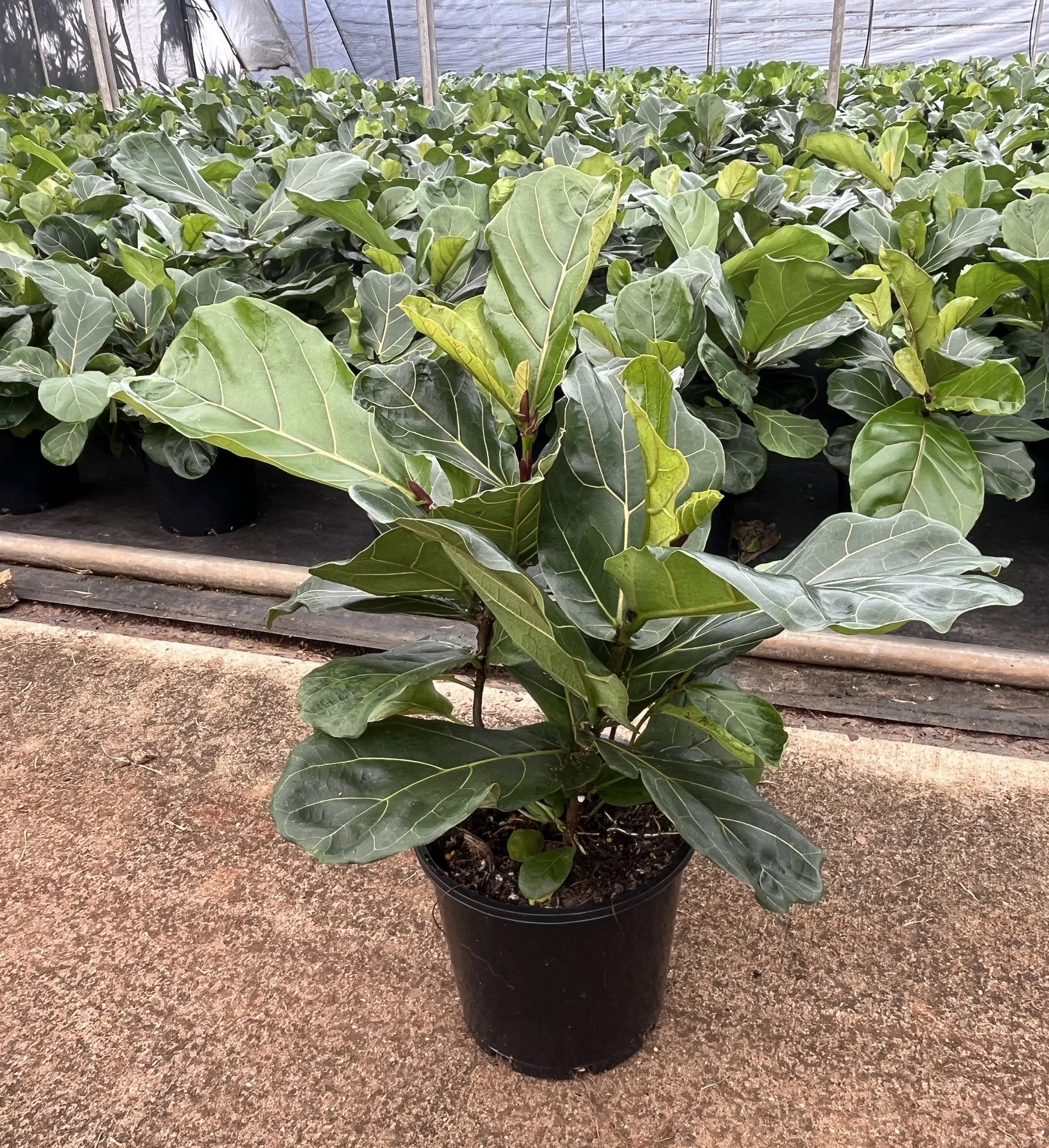 Image 1 of 1
Image 1 of 1


Ficus Lyrata 200mm
🌿 Ficus lyrata
Common Name: Fiddle Leaf Fig
Family: Moraceae (Fig family)
Origin: Native to tropical West Africa, from Cameroon to Sierra Leone
📏 Physical Description
Growth Habit:
A tall, upright evergreen tree or shrub, commonly grown as a houseplant.
Indoors, it can grow up to 2–3 meters (6–10 feet) tall, and much taller in the wild.
Often grown as a single trunk tree or a multi-stemmed bush.Leaves:
Large, glossy, violin-shaped (fiddle-shaped) leaves with prominent veining.
Each leaf can grow up to 30–45 cm long (12–18 inches).
Foliage is dark green with a leathery texture and a wavy edge—making it highly ornamental.Stems & Trunk:
Woody, upright, often trained to have a bare trunk with a crown of dramatic foliage.
🌱 Care and Cultivation
Light:
Thrives in bright, indirect light.
Can tolerate a few hours of gentle direct sun, but avoid intense afternoon rays.
Insufficient light can cause leaf drop and slow growth.Watering:
Allow the top 5–8 cm of soil to dry out before watering.
Water deeply, but make sure the pot has good drainage.
Avoid soggy roots—overwatering is a common cause of leaf issues.Humidity:
Prefers moderate to high humidity.
Can tolerate average indoor air but will thrive with occasional misting or a nearby humidifier.Soil:
Use a well-draining, fertile potting mix—ideally blended with perlite, orchid bark, or coarse sand for aeration.Temperature:
Best kept at 18–26°C (65–80°F).
Protect from cold drafts and never expose to temperatures below 10°C (50°F).Feeding:
Feed every 4–6 weeks in spring and summer with a balanced liquid fertilizer. Reduce in winter.Pruning:
Prune to control height, encourage branching, or shape the plant.
Ficus sap is sticky and irritating—wear gloves.Propagation:
Can be propagated via stem cuttings, though it's slow and challenging. Air layering is more reliable.
✅ Quick Care Summary
RequirementDetailsLightBright indirect (some morning sun OK)WaterLet topsoil dry before wateringHumidityModerate to high preferredSoilWell-draining, rich mixTemperature18–26°C; no drafts or cold airFeedingMonthly in spring and summerPropagationStem cuttings or air layering
✅ Perfect For:
Bold indoor feature plants
Modern homes, offices, and showrooms
Statement pieces in corners or large pots
Plant stylists and collectors
🌿 Ficus lyrata
Common Name: Fiddle Leaf Fig
Family: Moraceae (Fig family)
Origin: Native to tropical West Africa, from Cameroon to Sierra Leone
📏 Physical Description
Growth Habit:
A tall, upright evergreen tree or shrub, commonly grown as a houseplant.
Indoors, it can grow up to 2–3 meters (6–10 feet) tall, and much taller in the wild.
Often grown as a single trunk tree or a multi-stemmed bush.Leaves:
Large, glossy, violin-shaped (fiddle-shaped) leaves with prominent veining.
Each leaf can grow up to 30–45 cm long (12–18 inches).
Foliage is dark green with a leathery texture and a wavy edge—making it highly ornamental.Stems & Trunk:
Woody, upright, often trained to have a bare trunk with a crown of dramatic foliage.
🌱 Care and Cultivation
Light:
Thrives in bright, indirect light.
Can tolerate a few hours of gentle direct sun, but avoid intense afternoon rays.
Insufficient light can cause leaf drop and slow growth.Watering:
Allow the top 5–8 cm of soil to dry out before watering.
Water deeply, but make sure the pot has good drainage.
Avoid soggy roots—overwatering is a common cause of leaf issues.Humidity:
Prefers moderate to high humidity.
Can tolerate average indoor air but will thrive with occasional misting or a nearby humidifier.Soil:
Use a well-draining, fertile potting mix—ideally blended with perlite, orchid bark, or coarse sand for aeration.Temperature:
Best kept at 18–26°C (65–80°F).
Protect from cold drafts and never expose to temperatures below 10°C (50°F).Feeding:
Feed every 4–6 weeks in spring and summer with a balanced liquid fertilizer. Reduce in winter.Pruning:
Prune to control height, encourage branching, or shape the plant.
Ficus sap is sticky and irritating—wear gloves.Propagation:
Can be propagated via stem cuttings, though it's slow and challenging. Air layering is more reliable.
✅ Quick Care Summary
RequirementDetailsLightBright indirect (some morning sun OK)WaterLet topsoil dry before wateringHumidityModerate to high preferredSoilWell-draining, rich mixTemperature18–26°C; no drafts or cold airFeedingMonthly in spring and summerPropagationStem cuttings or air layering
✅ Perfect For:
Bold indoor feature plants
Modern homes, offices, and showrooms
Statement pieces in corners or large pots
Plant stylists and collectors